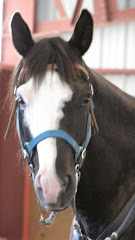I started a chat group, Horses Are Our Lives, to talk about Centered Riding and Training Tips. I would like to talk about what we are doing with our horses and what we hope to do. And we’ll talk about our rides, our achievements and our troubles.
If you would like to join the chat group, Horses Are Our Lives, go here:
http://sports.groups.yahoo.com/group/horsesareourlives/
and ask to join. If you don’t get an invite, than email me at horsesareourlives@yahoo.com
Last week we talked about the 2 point position as a Training Tip discussion. We also talked about the Centered Riding topic of Dancing Knees, which I will share tomorrow.
Normal body alignment while riding at the walk, is sitting with a straight back, with a straight line from the back of the ear, through the shoulders, in line with the hip and heel. A straight line from ear-shoulders-hip-heel. You maintain this line while posting. (Remember that I have been taught the QH English Equitation on the flat for shows, and I'm sure that you jumpers out there will have more suggestions to help achieve a balanced 2 point. I welcome all suggestions!)
In 2 point position, the body lifts out of the saddle slightly, and you lean slightly forward, keeping your back straight. You raise your hands slightly up the horse's neck to help maintain balance. You keep your feet on the "bubbling spring" of the foot, which is slightly behind the ball of the foot. I will talk about how to find this spot this week. The alignment in the body is a straight line from shoulders-knee-toe. Ear-shoulder - knee-toe.
Once again, as you raise up into 2 point, raise your hands slightly forward and up, to maintain balance. If this is difficult, hold the gullet at the front of the pommel with one hand and a shorten rein with the other hand. When things get out of control, sit down gently, pick up both reins, get control of your body and your horse, and start over.
Let me know if this helps, and where you are having trouble. Keeping the body relaxes is easier said than done, sometimes, but the dancing knees will help that.
Have fun practicing!
After some discussion on the chat group, here were some additional thoughts.
I tend to have too long of irons when I ride, but I think shorter irons help moving up in to 2 point. With your legs out of the irons, your irons should hit at the back of your ankle joint, maybe slightly higher. With western stirrups, you just lift your toe and that is the length of stirrup.
If you feel too short, try 1 hole longer, and remember that when we post or go in to 2 point, we do not need to come out of the saddle a lot, just enough so that there is a little air under us. The alignment should stay the same. You may have to go back to practicing with leather lengths if you wonder if your leathers are too short. I also goggled "English riding 2 point position", and try doing that also and reading a few descriptions on position and leg length.
Jumping position is 3 point (I said that wrong on the chat group and Sara corrected me). I will look through the books again, and see what I can find on position, and get back to you about where they talk about it in the book. The trouble I had when I goggled position is that they go in to jumper mode, and the rider is up and over the horse's neck, getting ready for the jump. Yes, the jumper has a shorter leg, and jumping is not my expertise at all, lol.
I'm probably using 2 point to a lesser degree than the jumpers. We won't lean up and over the horse's neck, as Jumpers stay parallel to the neck as they go over the jump. We will not be that far forward, unless you are going over jumps!
Another discussion that popped up last week was about the feel of different bridles with the same or different bits attached. My thoughts:
I get the same feel with any type of bridle, but I do have different feels with different bit (It doesn't matter if that bit is on a different type of bridle).
THIS IS MY OPINION: I have only heard a few old trainers say this: I have always believed that a snaffle bit isn't always a kind bit. Both my daughter Sara, who is on this chat also, and myself have seen the effect of taking a snaffle out of a horse's mouth and put a light curb in the horse's mouth, and the head tossing is gone! I know some horses have too sensitive mouth for a snaffle, as the snaffle "bites" the tongue. The curb gives relief to the tongue. The snaffle may hit the roof of the mouth at a point, where the curb may hit in in a gentle arch or not at all, depending on how high the curb is. Yes, checking the teeth is always a first thing to do. I would change to a mild low port curb. There are snaffle bits that are curbs, the kimberwicks, and I would try on of those on the English headstall.
Let me know if a different bit helps!
On the Horses Are Our Lives chat group, there was more discussion on the feel and use of Snaffle bits, Kimberwicks, and Curb bits with loose and solid shanks!
I hope you can come and discuss some ideas with us!
Hope to see you on the trail, and on a journey with your horse.
“Embrace the journey!”
Brenda
Turning Night to Day
9 years ago







No comments:
Post a Comment